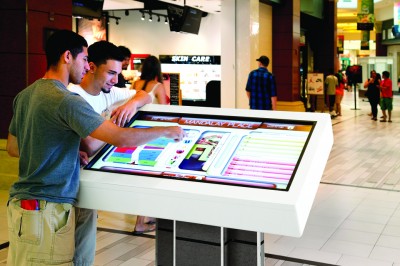Manager or machine?
Research firm DisplaySearch says the market for public displays, which crosses a variety of industries, is showing strong growth. The company predicts nearly 12 million units will be sold in 2018, up from less than three million in 2011, with some of this growth resulting in the increased adoption of interactive technologies.
“Touch-screen penetration is rapidly increasing,” says Jennifer Colegrove, vice-president (VP) of emerging display technologies. “Over the next several years, touch screens will undergo strong growth in large-format applications.”
Through these technologies, retailers can find new opportunities to engage and build relationships with their customers; but as interactivity grows more common, it raises questions about customer service. Retailers may well start to wonder whether customers interacting with machines will be better for their brands than customers dealing with in-store staff.
The answer has more to do with supplying customers with additional options than it does with rating one option better than another. Human interaction remains valuable, but interactive digital screens can enhance the retail experience further.
Some of today’s customers prefer to shop online than to walk into a brick-and-mortar store. And when they are in a store, they prefer to shop on their own, peruse in-store kiosks for information, make their purchase and leave as soon as possible. As salespeople will not affect what these customers want to buy, there is no traditional opportunity to upsell to them.
Other customers do want personal attention, however, so it is still important to have staff in place.

Touch screens have provided the foundation for a new generation of multi-function interactive systems.
Covering the bases
The upshot is today’s retailer has many options for meeting the demands of a variety of consumers, based on where and how they want to interact with the brand. Interactive digital signage simply introduces a new style of selling, which helps give retailers a better chance of capturing more of the market.
Some stores are already availing themselves of this new dynamic. Best Buy, for example, is well-known as a big-box retailer, but has also introduced interactive kiosks in airports to sell media players, headphones and other consumer products. This gives it a way to meet more customers’ needs, beyond its typical brick-and-mortar stores.
The Apple Store, meanwhile, has made sure that before a buyer can close out a sale—whether online, in a store or through a dedicate app—further options appear on-screen, such that cables and extended warranties will be part of the equation. These measures breed additional sales.
Interactive insight
There is much room for progress in the industry. Marketing and technology services firm SapientNitro’s Insights 2013 report indicates only 22 per cent of retailers are rated as truly interactive, with added value beyond simply merchandising or display content. Most of the others have so far failed to deploy digital signage with interactive technologies.
To make an interactive experience relevant, however, it is important to deliver the right messaging and content through technologically sound hardware and software that will draw customers in. Next, the experience has to be meaningful.
If the interaction with a kiosk or touch screen is a ‘bumpy’ experience or if customers have to scroll through too many products before they can place an order, many of them will walk away. Their time must be respected by guiding them through the process with a well-planned series of questions and interactions.

To extend further into mobile engagement, some retailers are letting customers use their smart phones as tools for interacting with video walls and other displays.
An interactive system built upon a good design should tie in with other systems and offer an enjoyable customer experience, leading to an increase in sales. So, before deploying interactive digital signage, retailers need to define their goals, strategies and plan.
Among other elements, this plan should cover:
- Which technologies will be used.
- Who will support the system.
- How results will be measured.
- Who will manage content.
- How content will be kept fresh and relevant.
- How the deployment may be expanded in the future.
The question is no longer whether or not to deploy interactive technologies, but when, with the plan in place to do so.
Richard Ventura is director of vertical market sales for NEC Display Solutions. For more information, contact him via e-mail at rventura@necdisplay.com or visit www.necdisplay.com.





